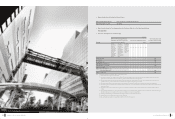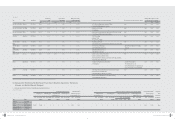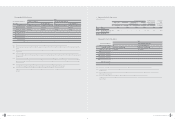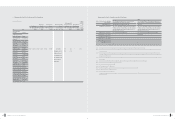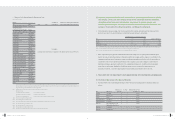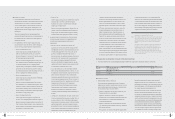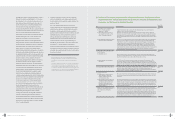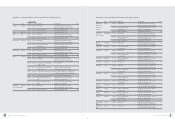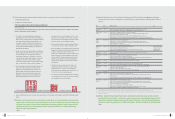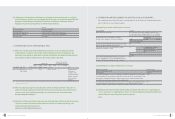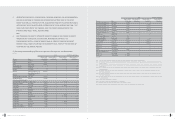HTC 2008 Annual Report Download - page 37
Download and view the complete annual report
Please find page 37 of the 2008 HTC annual report below. You can navigate through the pages in the report by either clicking on the pages listed below, or by using the keyword search tool below to find specific information within the annual report.
69
IV. CO RPO RATE GOVERN AN CE
68
2OO 8 HTC AN N UAL REPO RT
HTC began early to apply the newly amended valuation methods of
Statement of Financial Accounting Standards No. 10, the reserve
rate of allowances for loss on decline in inventory value or loss on
items retired was 18 percent of total inventory, an increase of 5
percent over the previous fiscal year. Product warranty reserves
were recalculated on the basis of past experience as well as a
special assessment performed for HTC by accounting firm Deloitte
& Touche, and the product warranty reserve rate for 2008 was set at
4 percent of net sales. Reasonable assessments have been
performed and reserves allocated for risk currently associated with
HTC intellectual property in order to reduce the degree of any
material effect on HTC finances, business, and operations.
During each quarter, supervisors also have regular individual
meetings with CPAs. Supervisors must first review and be satisfied
with CPA independence and the professional fees for attestation of
annual financial reports, which matters are then submitted to the
board of directors for resolution. In 2008 there was frequent
interaction between internal auditors and supervisors. In addition to
their regular monthly meetings with internal personnel, supervisors
also participated in interviews with the officers responsible for self-
assessment of internal controls and accompanied internal auditing
personnel on audits at overseas subsidiaries. The size of the
internal auditing staff expanded due to attention to the issue from
the supervisors and board of directors. Integration of internal
auditing and risk assessment has begun, and internal auditing is
being adjusted toward a more risk-based approach. Procedures are
now in place to guide pre-audit preparations, and steps are also
being put in place for pre-audit risk-assessment interviews with
officers. In internal auditing methods, the population-sample
distinction has been strengthened, and auditing programs are
continually undergoing adjustment and correction. Internal auditing
personnel must conduct cross-validations to help ensure that audit
procedures do not deviate from the proper direction and that
accurate internal auditing resources will be effectively utilized.
Due to the fact that risk assessment procedures are currently still
informal, risk assessments in 2009 will need to become
systematized and thoroughly documented. Internal audits and risk
assessments need to be more clearly and effectively linked, and
internal auditing should be applied to audits of risk items,
including off-book disclosures. As a larger staff of assistants is
called upon, related training issues must also be addressed.
Relevant material standards must be established and unified with
risk standards so that audits can be applied to risk items and audit
reports can more closely address matters of concern to the higher
levels of corporate management.
2. If supervisors in attendance at a board of directors meeting state
opinions, the meeting date, session number, agenda, and result of
resolutions must be noted, along with the company's handling of the
supervisors' opinions.
Prior to each quarterly meeting of the board of directors, HTC
convenes a regular supervisors meeting at which important matters
relating to finances, legal issues, and internal audits are reported to
the supervisors, and the supervisors in turn produce a quarterly
supervisors' report for submission to the board of directors. Important
related-party transactions are first submitted to the supervisors
meetings, which must first review the transactions and issue an
unqualified opinion that is then submitted for deliberation and
resolution by the board of directors. In proposals affecting one
interested party, the representative of juristic person supervisor Wei-
Chi Investment Co., Ltd. was voluntarily recused during the
supervisors meetings and board of directors meetings that touched on
the proposals. There has been no instance of a supervisor expressing
a dissenting opinion regarding a board of directors' resolution during
the most recent fiscal year.
Note : When a supervisor leaves his post prior to the closing date of the fiscal year, the
date shall be noted in the "notes" column and their attendance rate (as a
percentage) calculated based on the ratio of the number of directors meetings
during their term to the actual number of meetings at which they attended or
observed.
If an election for supervisors is held prior to the closing date of the fiscal year, the
old and new supervisors shall be listed, and a designation placed in the "notes"
column beside each indicating the date of the election and whether each is new,
old, or serving successive terms. Their attendance rates (as a percentages) shall be
calculated based on the ratio of the number of directors meetings during their term
to the actual number of meetings at which they attended or observed.
(3) The State of The Company's Implementation of Corporate Governance, Any Departure of Such
Implementation from The Corporate Governance Best-Practice Principles for TSEC/GTSM Listed
Companies, and The Reason for Any Such Departure
Item
1.
Shareholding structure & Shareholders' Rights
(1) Method of handling shareholder
suggestions or complaints
(2) The Company's possession of a list of
major shareholders and a list of ultimate
owners of these major shareholders
(3) Risk management mechanism and "firewall"
between the Company and its affiliates
2. Composition and Responsibilities of the
Board of Directors
(1) Independent Directors
(2) Regular evaluation of external auditors'
independence
3.
Communication channel with stakeholders
4. Information Disclosure
(1) Establishment of a corporate website to
disclose information regarding the
Company's financials, business and
corporate governance status
(2) Other information disclosure channels (e.g.,
maintaining an English-language website,
appointing responsible people to handle
information collection and disclosure,
appointing spokespersons, webcasting
investors conference)
5. Operations of the Company's Nomination
Committee, Compensation Committee, or
other committees of the Board of
Directors
Implementation Status
>To guarantee shareholders' rights and interests, HTC has established spokespersons to properly handle any
suggestions, doubts, or disputes involving shareholders.
>When HTC provides shareholder registers in accordance with book closures carried out at the company by the
shareholder services agent, the registers indicate the major shareholders controlling the company and the persons
with ultimate control over the major shareholders. HTC, in accordance with regulations, also provides information
regularly on pledges and the increase and decrease in shareholdlings of shareholders with a more than 10% stake in
the company.
>The division of responsibilities and duties between HTC and its affiliated enterprises with respect to management of
personnel, resources, and finances are clear, while risk assessments are rigorously performed and appropriate
firewalls have been set up. HTC conducts business relations with affiliated enterprises on the principles of fairness
and reasonableness, while observing the Transaction Operating Procedure for HTC Corporation's Designated
Company, Enterprise Group and Related Person and other related regulations such as those governing internal
controls. In matters governed by contract, the terms and conditions for pricing and payment methods have been
clearly prescribed, and both non-arms-length transactions and financial tunneling are prohibited. As duly requested,
the shareholders meeting and the board of directors have adopted resolutions eliminating non-competition
restrictions with respect to directors and managerial officers.
>At the end-of-term elections for directors and supervisors at the 2007 ordinary shareholders meeting, the HTC
voluntarily selected two independent directors in accordance with the provisions of the Securities and Exchange Act;
the number of independent directors exceeds one-fifth of the total number of directors.
>In 2008 HTC switched to regularly scheduled annual reviews and assessments of the independence of CPAs
performed by the supervisors, and prior to submitting a proposal to the board of directors for deliberation on a
change in CPAs, it submits the academic and professional qualifications of the CPA to the supervisors meeting and
arranges for the CPA to be interviewed by the supervisors in order to review and assess their independence. HTC will
draw up plans in the future to have the supervisors perform regular assessments of the independence of the CPA.
>HTC provides detailed contact information, including telephone numbers and email address, in the "contact us"
space on its corporate website. We have put personnel in place to exclusively deal with messages to the
spokesperson mailboxes and investor email mailboxes so that various subject parties (including interested parties)
will have channels for communication with HTC as circumstances require.
>
HTC has also set up both Chinese and English websites. Investor information pages include information on financial and
business issues and corporate governance, while product information pages provide information relating to our products
and businesses.
>HTC has set up English and Chinese investor relations websites, and dedicated personnel have been appointed who
are responsible for collecting information and making timely updates to website content. HTC Chief Financial Officer
Hui-Ming Cheng has been appointed spokesperson, and a spokesperson email address has been established with an
employee exclusively responsible for its handling, in order to implement the spokespersons system. An investors
conference is convened online each quarter, with sound recording and presenation of the proceedings posted on the
company website after the conference.
>
After the term-end elections for directors and supervisors at its ordinary shareholders meeting of 2007, HTC's board of
directors chose Compensation Committee members in accordance with provisions of the Compensation Committee Articles
of Incorporation drafted by the board of directors, i.e., that the Compensation Committee shall be composed of three
directors with the chairman of the board as ex officio chairman and the remaining two appointed by the board of directors,
and that at least one shall be an independent director. At the board of directors meeting of 22 June 2007, director HT Cho
and independent director Chen-Kuo Lin were appointed to the Compensation Committee, while Chairman Cher Wang was
made its chairman. The principal duties of the Compensation Committee include assisting the board of directors in
supervising the company's compensation system and making appropriate recommendations to the board.
Reson for Non-
implementation
None
None
None
None
None
'0 8A R_ HT C/ 英文版* NEW 05/ 21/ 20 09 11: 02 頁面 6 8




